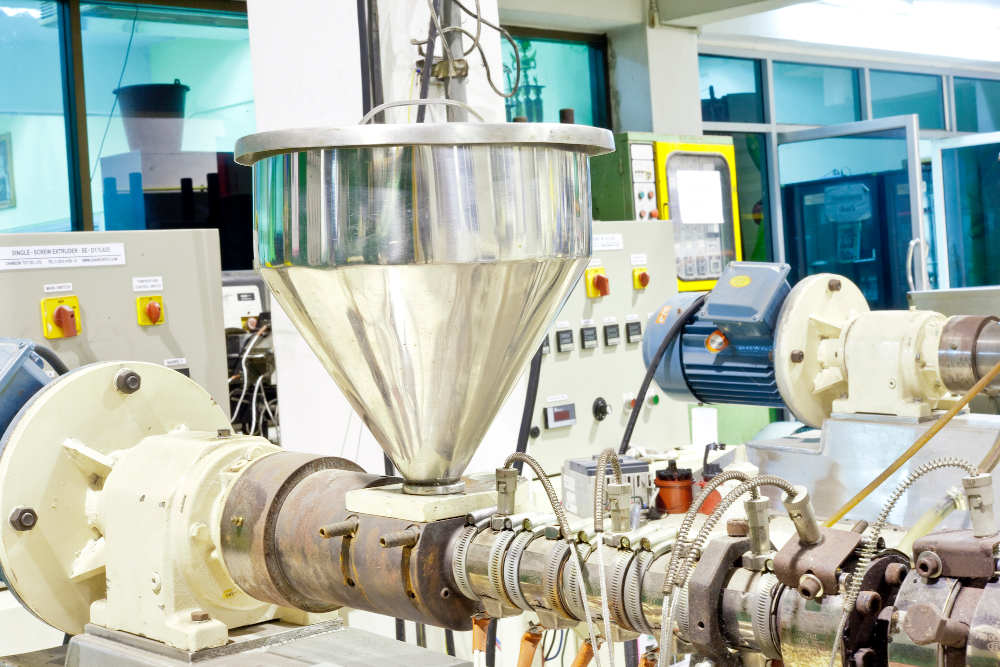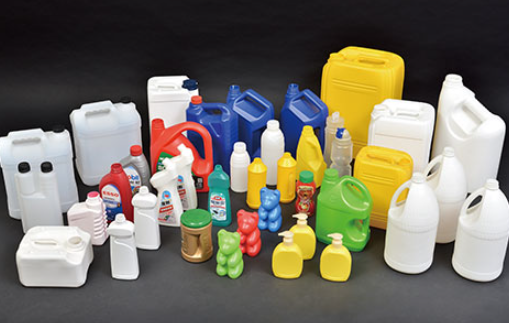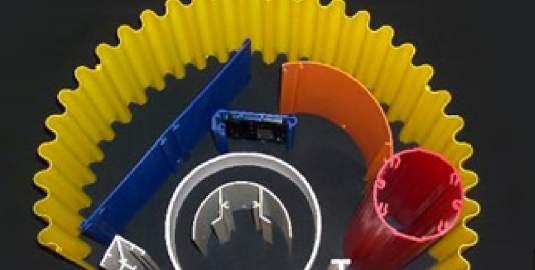Extruded materials are cooled using air, water, or contact and non-contact cooling techniques, tailored to material properties.
Types of Cooling Methods in Extrusion
Air Cooling Systems
Basics and Applications
Air cooling systems, often used in extrusion, utilize ambient or forced air to remove heat from extruded materials. They are commonly employed for materials sensitive to moisture or those with lower cooling requirements.

Advantages:
Lower cost: Typically less expensive to install and maintain compared to water cooling systems.
Simplicity: Easier to operate, with minimal risk of corrosion or scaling.
Limitations:
- Lower efficiency: Air is less effective in heat removal compared to water, leading to potentially slower cooling rates.
- Environmental impact: Efficiency can be influenced by ambient temperature and humidity.
Technical Specifications
Cooling capacity: Ranges from low to moderate, depending on the fan size and air flow rate.
Power consumption: Generally lower than water cooling systems, often ranging from 1 kW to 5 kW, depending on the system size and design.
Water Cooling Systems
Basics and Applications
Water cooling systems are more effective for materials requiring rapid cooling. These systems circulate water or water-based coolants around the extruded material, efficiently removing heat.
Advantages:
- High efficiency: Water has a higher heat capacity than air, allowing for quicker and more consistent cooling.
- Flexibility: Can be designed to accommodate a wide range of cooling needs and extrusion speeds.
Limitations:
Cost: Generally more expensive in terms of installation, operation, and maintenance.
Maintenance requirements: More prone to issues like corrosion, scaling, and biological growth.
Technical Specifications
- Cooling capacity: Significantly higher than air systems, suitable for high-speed and high-temperature extrusions.
- Power consumption: Varies widely, but generally higher than air systems, especially in systems with pumps and chillers, often ranging between 5 kW to 20 kW.
Contact and Non-Contact Cooling Techniques
Contact Cooling
In contact cooling, the extruded material is directly exposed to the cooling medium, such as cooled rollers or belts.
Advantages:
- Direct cooling: Offers efficient heat transfer due to direct material contact.
- Controlled cooling: Allows for precise control over the cooling rate and material properties.
Limitations:
- Material restrictions: Not suitable for materials that are sensitive to physical contact during cooling.
Non-Contact Cooling
Non-contact cooling involves methods like radiation or convection without direct physical contact with the cooling medium.
Advantages:
Versatility: Suitable for a wide range of materials, including those sensitive to physical deformation.
Uniform cooling: Reduces the risk of deformities or stress concentrations in the material.
Limitations:
Efficiency: Generally less efficient than contact methods, requiring careful design and control.
Technical Specifications
Cooling efficiency: Varies with the method and design; contact methods generally offer higher efficiency.
Application range: Wide, covering a broad spectrum of materials and extrusion processes.
Factors Influencing Cooling Efficiency
Material Properties and Their Impact on Cooling
The cooling efficiency in the extrusion process is significantly influenced by the material properties of the product being extruded. Materials with high thermal conductivity, like aluminum, transfer heat more effectively, thus cooling faster compared to materials like high-density polyethylene (HDPE) with lower thermal conductivity. The specific heat capacity of the material also plays a crucial role. Materials with high specific heat capacities require more energy to cool down, potentially increasing the cooling time and energy costs.
Materials that are more viscous when molten tend to retain heat longer, necessitating longer cooling periods or more efficient cooling methods. The melting point of the material directly impacts the cooling process; materials with higher melting points often require more aggressive cooling strategies.
Extrusion Speed and Cooling Correlation
Extrusion speed is a critical factor in determining the efficiency of the cooling process. Higher extrusion speeds result in a higher output rate but can compromise the cooling efficiency. Faster extrusion speeds mean the material spends less time in the cooling zone, which can lead to incomplete cooling or product deformities.
In situations where extrusion speed is increased, cooling systems need to be more effective to handle the increased heat output. This might involve higher capacity cooling systems, which can increase power consumption, sometimes up to 20-30% more, depending on the material and extrusion speed. The relationship between extrusion speed and cooling efficiency necessitates a delicate balance to ensure product quality while maintaining production efficiency.
Environmental Factors Affecting Cooling
Environmental factors, including the ambient temperature, humidity, and air flow in the manufacturing facility, can also impact the cooling efficiency. Higher ambient temperatures can reduce the cooling rate, as the temperature gradient between the extruded material and the environment decreases. This can lead to longer cooling times or the need for more powerful cooling systems, which in turn can increase operational costs.
Humidity plays a role particularly in air-cooling systems, where high humidity can reduce the efficiency of heat transfer from the material to the air. Manufacturers might need to consider dehumidifying solutions in high-humidity environments to maintain cooling efficiency.
Effective cooling in extrusion processes is a complex interplay of these factors. Understanding and optimizing these variables are crucial for achieving the desired product quality while maintaining cost efficiency. Solutions like advanced thermal management systems and process monitoring can help in fine-tuning the cooling process in accordance with these diverse factors.

Cooling Systems Design and Optimization
Optimizing cooling systems in extrusion processes involves a comprehensive understanding of both the extrusion process and the properties of the materials being extruded. Effective cooling system design can significantly enhance product quality, improve energy efficiency, and reduce operational costs.
Design Considerations for Effective Cooling
When designing cooling systems for extrusion processes, several critical factors come into play:
- Heat Transfer Efficiency: The system must effectively remove heat from the extruded material. This involves selecting the right cooling medium (air or water) and designing the system to maximize contact with the material.
- System Capacity and Scalability: The cooling system should match the extrusion process’s scale and be adaptable to future expansions or modifications.
- Energy Consumption: Systems should be energy-efficient, balancing cooling effectiveness with power usage. Optimally designed systems can save significant amounts on electricity bills; for example, using energy-efficient fans or pumps can reduce energy consumption by up to 20-30%.
- Maintenance Requirements: Easy-to-maintain systems reduce downtime and operational costs. This includes considerations for corrosion resistance, scaling, and ease of cleaning.
- Integration with Production Line: The cooling system must seamlessly integrate with the existing production line, considering factors like space constraints and compatibility with other machinery.
Technological Advances in Cooling Systems
Recent technological advancements have significantly improved the efficiency and effectiveness of cooling systems in extrusion processes:
Advanced Heat Exchangers: Modern heat exchangers offer improved heat transfer rates, ensuring quicker cooling without compromising material properties.
Automated Control Systems: These systems use sensors and AI algorithms to continuously monitor and adjust cooling parameters, ensuring optimal performance.
Eco-friendly Refrigerants: New cooling systems employ environmentally friendly refrigerants, reducing the ecological impact of the cooling process.
High-efficiency Motors and Pumps: These components reduce energy consumption, lowering operational costs.
Balancing Cooling Speed and Material Integrity
Achieving the right balance between cooling speed and maintaining the material’s integrity is crucial:
Optimal Cooling Rate: Too fast cooling can cause material stress or deformation, while too slow cooling can reduce production efficiency. Finding the optimal rate is key, which often involves trial and error and detailed knowledge of the material’s properties.
Uniform Cooling: Ensuring uniform cooling across the material prevents internal stresses and product warping.
Material Compatibility: The cooling system must be compatible with the material’s thermal and physical properties. For instance, materials with high thermal expansion coefficients require careful cooling to avoid cracks or distortions.
Monitoring and Controlling Cooling in Extrusion Processes
Effective monitoring and control of the cooling process in extrusion are vital for maintaining product quality and operational efficiency. Advanced techniques and technologies play a crucial role in this aspect.
Temperature Monitoring Techniques
Temperature monitoring is fundamental in controlling the cooling process. Various methods are employed depending on the accuracy required and the nature of the extruded material.
- Thermocouples and RTDs (Resistance Temperature Detectors): These are widely used for their accuracy and reliability. Thermocouples are suitable for a wide range of temperatures and are relatively inexpensive, making them ideal for various applications.
- Infrared Sensors: These non-contact sensors measure the surface temperature of extruded materials, useful in applications where physical contact is not feasible.
- Thermal Imaging Cameras: They provide a visual representation of temperature distribution across the material, helping to identify uneven cooling zones.
Automated Control Systems for Cooling
Automated control systems significantly enhance the efficiency and consistency of the cooling process.
PLC (Programmable Logic Controller) Based Systems: These systems allow precise control over cooling parameters, adjusting in real-time based on the feedback from temperature sensors.
PID (Proportional-Integral-Derivative) Controllers: They maintain the desired temperature by adjusting the cooling rate based on the difference between the actual and desired temperatures.
SCADA (Supervisory Control and Data Acquisition) Systems: For larger operations, SCADA systems offer centralized control and monitoring, integrating various aspects of the production process, including cooling.
Challenges in Cooling Process Control
Controlling the cooling process in extrusion faces several challenges:
Material Variability: Different materials respond differently to cooling, requiring customized cooling strategies.
Environmental Fluctuations: Changes in ambient temperature or humidity can affect the cooling efficiency, necessitating adaptive control systems.
Equipment Limitations: Older cooling systems might lack the precision or responsiveness needed for optimal control, leading to a potential upgrade or retrofitting requirement.
Energy Efficiency: Balancing cooling effectiveness with energy consumption remains a challenge. Overcooling can lead to unnecessary energy expenditure, while undercooling can affect product quality.

Maintenance and Troubleshooting of Cooling Systems
Proper maintenance and efficient troubleshooting are critical for ensuring the reliability and efficiency of cooling systems in extrusion processes. Regular maintenance not only extends the lifespan of the equipment but also ensures it operates at optimal efficiency, thus saving costs and maintaining product quality.
Routine Maintenance Practices
Regular maintenance practices for cooling systems typically include:
- Cleaning and Inspection: Regular cleaning of cooling system components, such as filters, fans, and cooling towers, is essential. This prevents the buildup of debris which can reduce efficiency. For example, a dirty filter can increase energy consumption by up to 5-10%.
- Leak Checks: Regularly checking for leaks in cooling systems, especially in water cooling systems, can prevent water loss and potential damage to the equipment.
- Thermal Fluid Analysis: In systems using thermal fluids, periodic analysis can detect contamination or degradation of the fluid, which can significantly impact the system’s efficiency.
- Component Testing: Regular testing of critical components like pumps, valves, and sensors ensures they are functioning correctly and helps in early detection of potential failures.
Common Cooling System Issues and Solutions
Common issues encountered in cooling systems include:
- Reduced Cooling Efficiency: Often caused by clogged filters or air inlets, which can be resolved through regular cleaning and maintenance.
- Water Leakages in Water Cooling Systems: Can be addressed by regular inspection and replacing worn-out hoses or fittings.
- System Overload: Caused by inadequate system capacity or extrusion running at higher speeds than the cooling system can handle. This may require system upgrades or process adjustments.
- Sensor Malfunction: Can lead to incorrect temperature readings and inefficient cooling. Regular calibration and maintenance of sensors are crucial.
Upgrading and Retrofitting Cooling Systems in Extrusion
Upgrading and retrofitting existing cooling systems can significantly improve efficiency and adapt to increased production demands.
- Installing More Efficient Components: Replacing older components with energy-efficient ones, like high-efficiency motors or advanced heat exchangers, can reduce energy consumption and improve cooling performance.
- Automation Upgrades: Implementing automated control systems can improve the precision and responsiveness of the cooling process, leading to better quality control and reduced energy usage.
- System Expansion: For increasing production capacity, expanding the cooling system to handle higher throughput is often necessary. This might involve adding additional cooling units or enhancing existing ones.




